Best Practices Articles
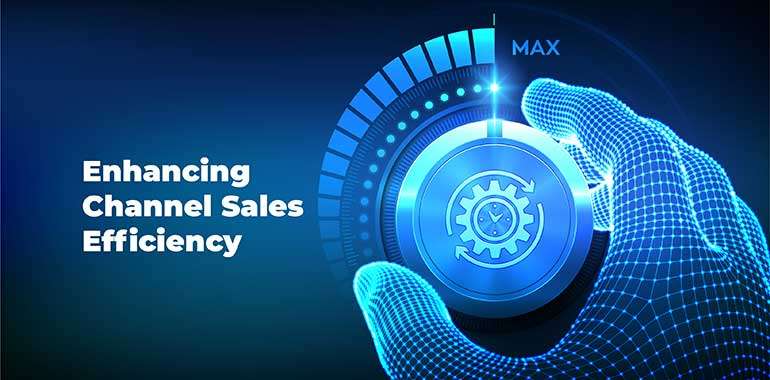
Enhancing Channel Sales Efficiency: The Critical Role of Workflow Automation
Table of Contents
- What are the benefits of channel sales?
- How do I find the right channel partners?
- How do I build and manage a successful channel sales program?
- How do I motivate and incentivize my channel partners?
- How do I measure the success of my channel sales program?
- What are some common challenges in channel sales, and how can I overcome them?
- What are some best practices for channel sales?
- What are the latest trends in channel sales?
- How can I use technology to improve my channel sales program?
- What are some resources that can help me with channel sales?
In the dynamic world of sales, channel sales have emerged as a vital strategy for businesses aiming to expand their market reach and enhance revenue streams. Channel sales, the process of distributing products or services through third-party entities, offers a unique blend of opportunities and challenges. However, the key to unlocking its full potential lies in the effective integration of workflow automation.
Workflow automation, a technology-driven approach to streamline business processes, is no longer a luxury but a necessity in channel sales. It is crucial to simplify complex sales processes, ensure efficiency, and maintain consistency across various channels. By automating repetitive tasks, companies can focus on strategic aspects such as partner selection, program development, and performance analysis.
This article aims to provide a comprehensive overview of channel sales, focusing on how workflow automation can significantly enhance each aspect of this sales model. From identifying the right channel partners to measuring the success of your program, we will explore how automation can be a game-changer in your channel sales strategy. We will also delve into the latest trends, common challenges, and best practices in channel sales, offering insights into how technology can be leveraged to overcome obstacles and achieve sales excellence.
Join us as we navigate the intricacies of channel sales, uncovering the pivotal role of workflow automation in driving success and efficiency in this competitive landscape.
Based on the information from ZINFI’s website, here are detailed answers to your questions about channel sales, emphasizing the critical role of workflow automation in each area.
1. What are the benefits of channel sales?
Channel sales, a method of distributing products or services through third-party partners, offers numerous benefits, including expanded market reach, cost efficiency, and enhanced scalability. Workflow automation is crucial in optimizing these benefits by streamlining processes and improving partner management. The most important benefits include:
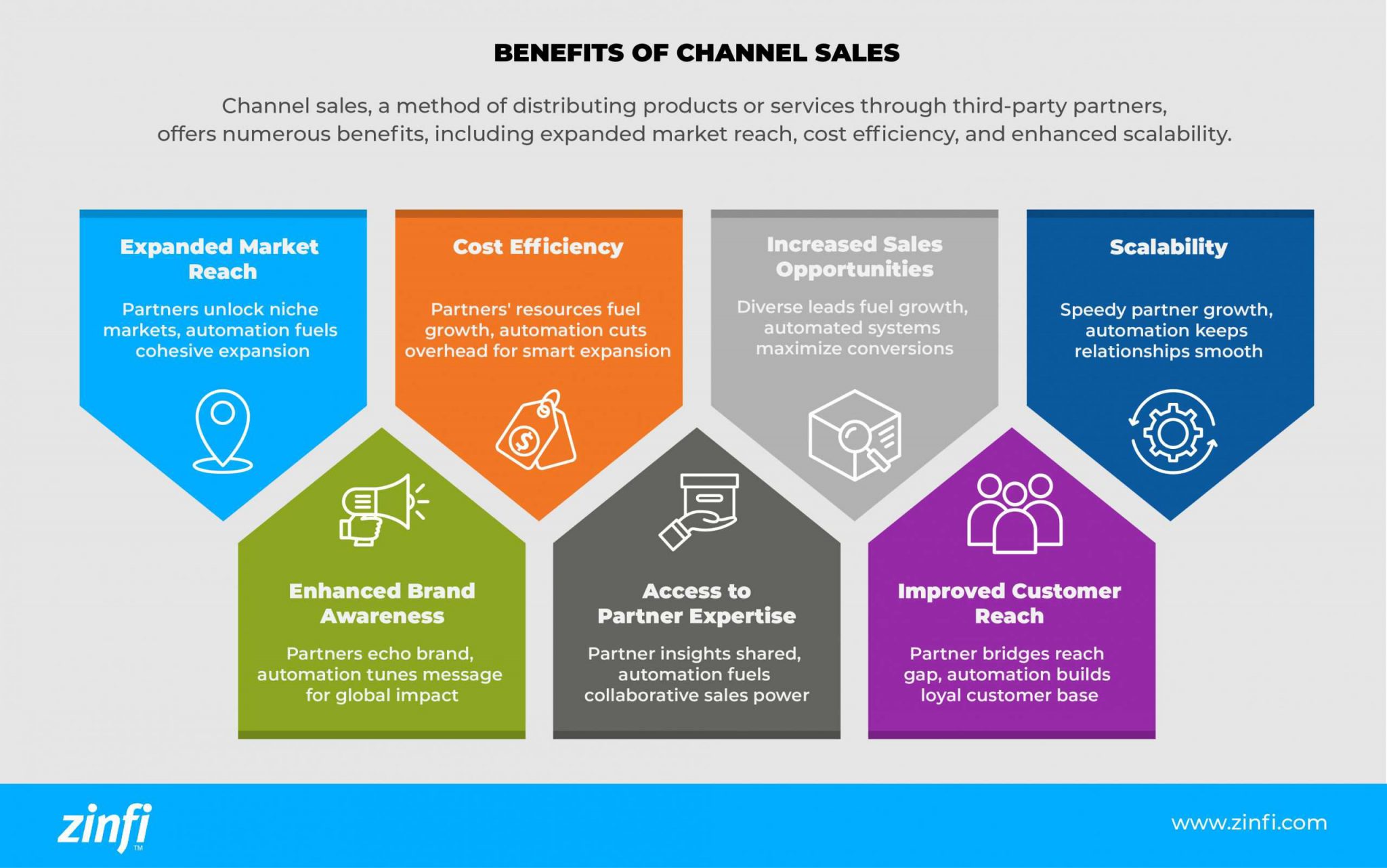
- Expanded market reach: Channel sales not only open doors to new geographic territories but also to niche markets that may have been previously inaccessible. Workflow automation tools streamline the integration of partners’ insights and strategies, ensuring a cohesive approach to market expansion. This harmonized strategy allows for more effective penetration of diverse markets, leveraging each partner’s unique strengths and local knowledge.
- Cost efficiency: Utilizing channel partners’ resources means companies can minimize their investment in building extensive sales infrastructures. Automated workflows are pivotal in optimizing the coordination and communication between the company and its partners. This efficiency reduces the need for comprehensive manual oversight, reducing administrative expenses and enabling a more cost-effective expansion strategy.
- Increased sales opportunities: The diverse customer bases of various partners mean a broader spectrum of potential sales leads. Automated lead management systems distribute these leads more effectively and track their progress and outcomes. This ensures that every opportunity is noticed and that the most promising leads are pursued with the appropriate level of attention and resources, thereby maximizing the potential for sales growth. Read more.
- Scalability: The ability to scale operations rapidly is a significant advantage of channel sales. Automation tools are crucial in enabling and managing this scalability because they can efficiently handle sudden increases in transactions and interactions. Successful scalability means driving more sales while maintaining the quality of relationships and consistency in service or product delivery as the business grows.
- Enhanced brand awareness: A brand’s message and identity can be amplified across various markets through a network of partners. Workflow automation ensures this branding is consistent and aligned with the company’s core values and messaging. This consistency is critical to building a strong, recognizable brand that resonates with a broad audience.
- Access to partner expertise: Channel partners often bring a wealth of local or specialized market knowledge that can be invaluable. Automated tools for communication and training facilitate the sharing of this expertise, ensuring that all parties are aligned and can benefit from each other’s strengths. This collaborative approach enhances the overall effectiveness of the sales strategy.
- Improved customer reach: Channel partners can bridge the gap for customers who need more support as targets of a company’s direct sales efforts. Automation in customer relationship management plays a critical role here. Software tools ensure that customer interactions are tracked and managed effectively, leading to stronger relationships and a better understanding of customer needs and preferences. This improved reach is essential for expanding a customer base and building long-term customer loyalty.
2. How do I find the right channel partners?
Finding the right channel partners involves identifying businesses that align with your company’s values, goals, and target markets. Workflow automation aids in this process by providing tools for efficient partner screening, onboarding, and management. Automation helps companies:
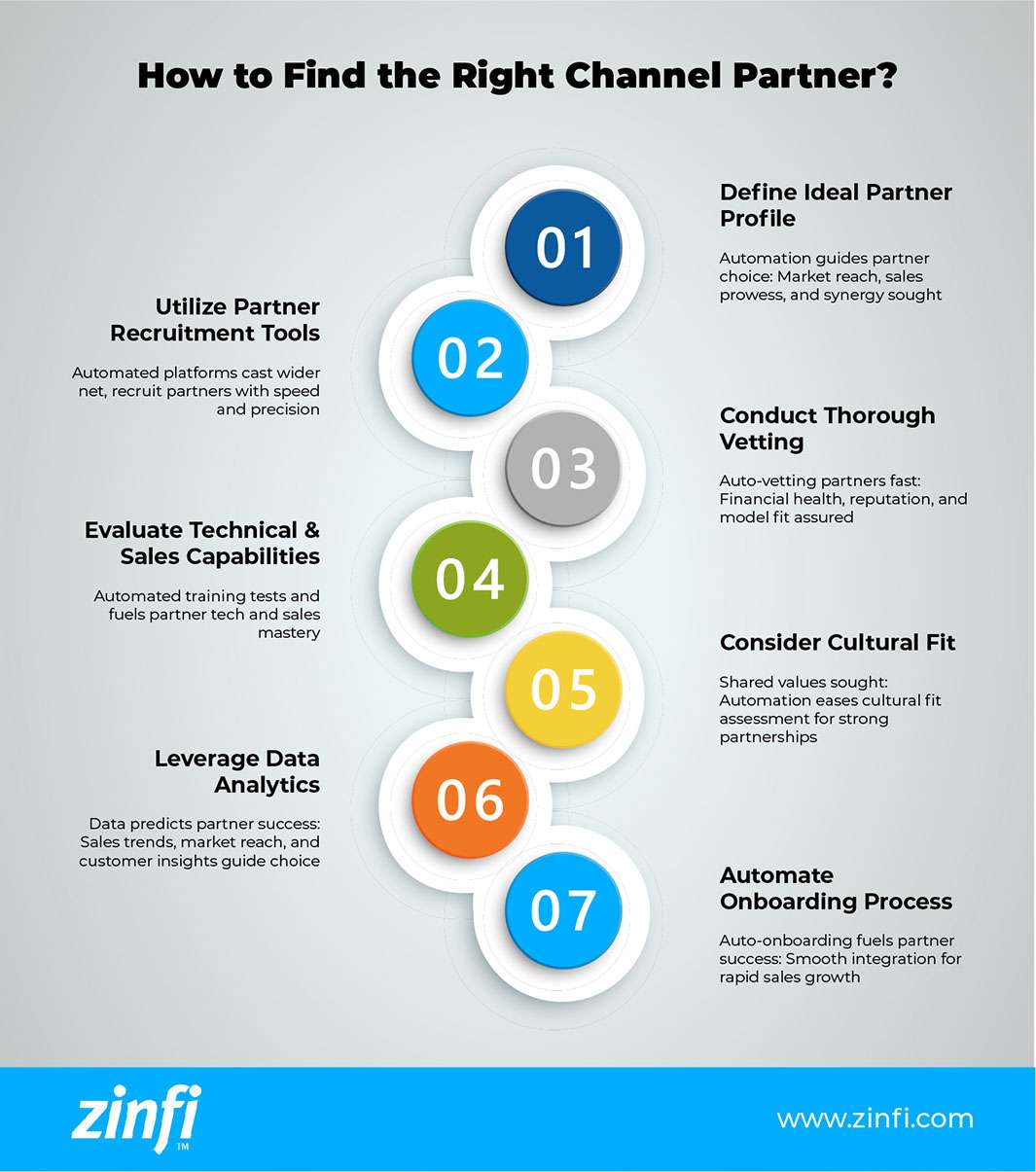
- Define the ideal partner profile. When establishing criteria for a perfect partner, it’s crucial to consider their market presence, which reflects their influence and reach. A solid customer base indicates a partner’s ability to market and sell products effectively. Complementary product offerings can lead to synergistic relationships, enhancing the value proposition for both parties. Automation tools streamline this process by filtering out potential partners not aligned with these critical criteria, ensuring a more focused and effective partnership strategy. Read more.
- Utilize partner recruitment tools. Automated partner recruitment platforms are invaluable in expanding the reach of your partner search. These tools cast a wider net to attract diverse potential partners and bring efficiency to the recruitment process. They can handle large volumes of inquiries, sort applications based on predefined criteria, and manage communications, making the recruitment process more streamlined and less labor-intensive.
- Conduct thorough vetting. Automated systems for vetting potential partners are essential for a robust channel sales strategy. These systems can quickly analyze critical factors such as financial stability, which strongly indicates a partner’s long-term viability and reliability. Market reputation analysis provides insights into potential partners' business practices and customer relationships. Compatibility with your business model is crucial for ensuring a seamless partnership. Automation in this process speeds up the vetting while maintaining thoroughness and accuracy.
- Evaluate technical and sales capabilities. Assessing a potential partner’s technical expertise and sales proficiency ensures they can effectively sell and support your products. Automated training and certification programs serve a dual purpose here. They help evaluate a partner’s current capabilities and offer opportunities for partners to improve their skills, ensuring they are well-equipped to meet sales targets and technical challenges.
- Consider cultural fit. The importance of cultural alignment must be considered in forming successful partnerships. To foster collaborative and trusting relationships, it’s essential to identify and recruit partners with similar values and business ethics. Automated communication tools can facilitate initial discussions, surveys, and assessments, helping to gauge cultural compatibility early in the recruitment process.
- Leverage data analytics. Data analytics tools play an essential role in evaluating the potential performance of prospective partners. By performing analysis of historical data and current market trends, these tools provide insights into how well a partner might perform in the future. This analysis focuses on factors like sales trends, market penetration, and customer feedback, offering a data-driven approach to partner selection.
- Automate the onboarding processes. The onboarding process is critical in establishing a successful new partnership. Automated onboarding tools significantly enhance this process by providing systematic and efficient ways to integrate new partners into your channel ecosystem. These tools offer step-by-step guidance, essential resources, and training modules, ensuring that partners are well-prepared to start selling and promoting your products effectively from the outset.
3. How do I build and manage a successful channel sales program?
Building and managing a successful channel sales program requires the creation of a structured framework that supports partner growth and aligns with your business objectives. Workflow automation helps streamline program management, training, and performance tracking. Steps in program development include the following:
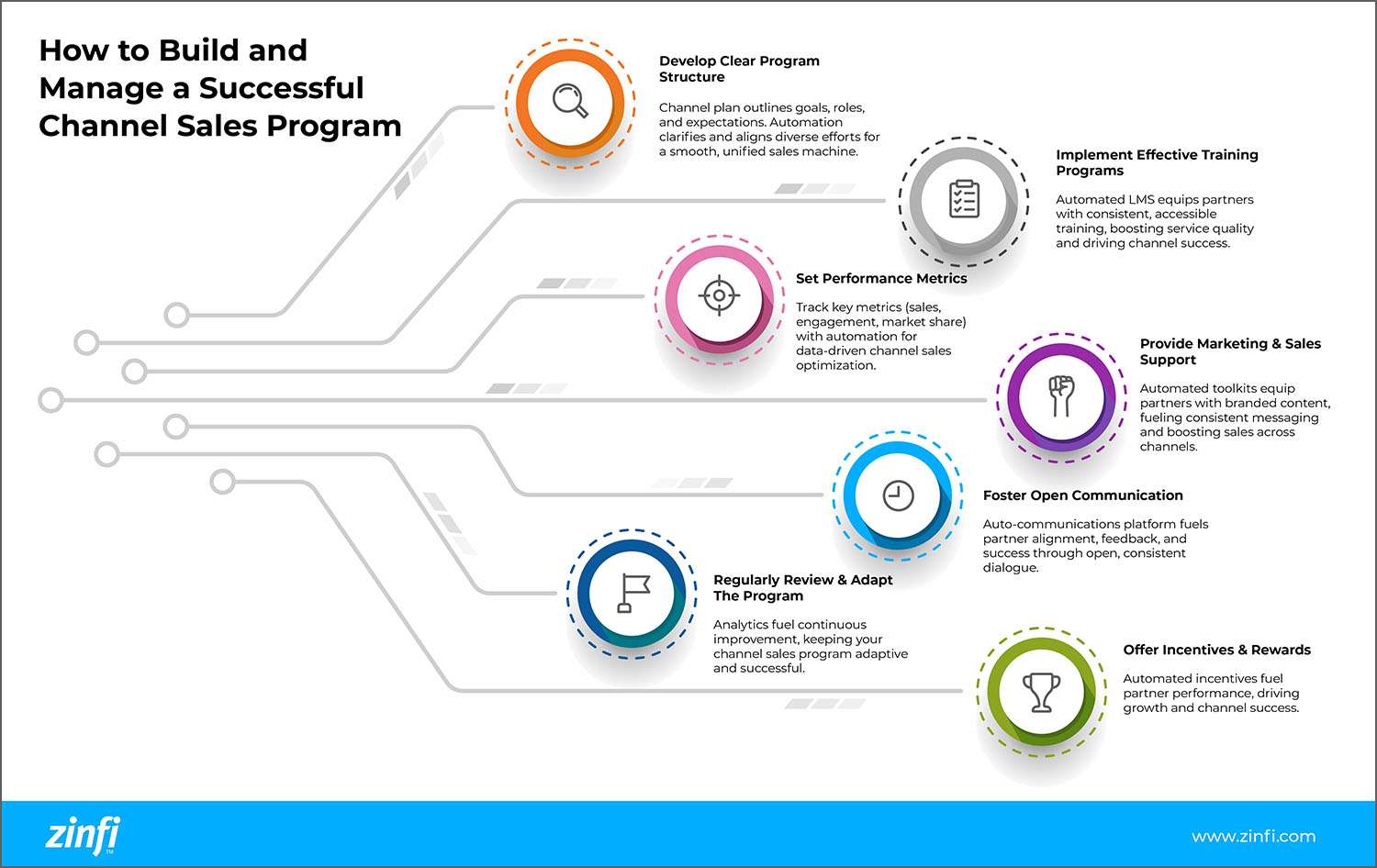
- Develop a clear program structure. A well-defined channel sales program structure is crucial for clarity and efficiency. It should outline specific goals, delineate roles and responsibilities, and set expectations for all involved parties. Automation tools can be instrumental in creating and distributing this structure, ensuring that every partner clearly understands the program’s objectives and their role within it. This clarity helps in aligning efforts and streamlining operations across various channels.
- Implement effective training programs. Automated learning management systems (LMS) are essential for delivering comprehensive training to channel partners. These systems provide a range of training materials, from product details to advanced sales techniques, in a format that is accessible and consistent. By ensuring that all partners are equally informed and skilled, these programs help maintain a high standard of service and knowledge across the board, ultimately contributing to the overall success of the channel sales program.
- Set performance metrics. To accurately evaluate the success of your channel sales program, you must establish and track clear performance metrics. Automated tools can monitor various metrics such as sales targets, customer engagement levels, and market penetration. These tools provide real-time performance data and help identify trends and areas for improvement, enabling a more strategic approach to managing channel sales.
 Download the best practices guidebook.
Download the best practices guidebook. - Provide marketing and sales support. Leveraging automation tools to equip partners with essential marketing materials, sales enablement content, and co-branded assets is the best approach to developing a cohesive sales strategy. These tools ensure all partners can access up-to-date, brand-consistent materials, which is crucial for maintaining a unified brand image and message across different sales channels. This support empowers partners to market and sell products effectively and enhances overall sales performance.
- Foster open communication. Implementing automated communication platforms is fundamental for maintaining open, transparent, and consistent communication with channel partners. These platforms make providing regular updates more accessible and efficient and encourage feedback exchanges and collaborative discussions so that all partners align with the program’s goals and strategies. Effective communication is critical to building solid relationships and addressing any issues promptly, which is essential for the success of a channel sales program.
- Offer incentives and rewards. Utilizing automated systems to manage and distribute incentives and rewards effectively motivates channel partners. These systems can track sales performance, manage commission structures, and administer rewards programs. When you offer tangible incentives for high performance, partners are motivated to achieve better results, contributing to the growth and ongoing success of the channel sales program.
- Regularly review and adapt the program. To ensure long-term success, you must continuously assess your channel sales program. Use analytics tools to periodically review the program’s performance, gather insights, and identify areas that need improvement or adjustment. This ongoing evaluation allows for timely adaptations to changing market conditions, partner feedback, and business objectives, and it will help ensure the channel sales program remains effective and aligned with overall business goals.
4. How do I motivate and incentivize my channel partners?
Motivating and incentivizing channel partners involves understanding their needs and goals and providing them with the right financial and non-financial rewards. Automation plays a crucial role in managing incentive programs and tracking partner performance. Here are some essential steps in building a robust incentive program:

- Understand partner motivations. Determining what motivates your partners is crucial for a successful collaboration. Whether they are driven by financial gains, public recognition, or growth opportunities, you must understand what drives each partner’s behavior. Automated surveys and feedback tools efficiently gather this information, allowing you to tailor your approach to each partner’s unique drivers and fostering a more productive and mutually beneficial relationship.
- Develop a comprehensive incentive program. A well-rounded incentive program is the best means of motivating channel partners. Such a program should encompass financial rewards, like commissions and bonuses, which directly benefit the bottom line, and non-financial rewards, such as training opportunities and exclusive rights, which can enhance partner skills and engagement. Utilizing automation tools to manage and track these incentives ensures seamless and fair distribution, encouraging ongoing partner enthusiasm and commitment.
- Offer performance-based rewards. Implementing a tiered reward system creates a healthy competitive environment that encourages partners to strive for higher sales and better performance. By utilizing automated tracking systems, you can accurately monitor partner achievements and allocate rewards transparently and efficiently. This motivates partners to excel and ensures their efforts are recognized and rewarded, reinforcing their commitment to your products or services.
- Provide marketing and sales support. Even the most motivated partners require the right tools to succeed. Automated marketing tools and sales enablement resources, such as digital brochures, product demos, and CRM systems, empower partners to market and sell your products effectively. This support enhances their sales capabilities and ensures brand messaging and strategy consistency across all channels.
- Recognize and celebrate success. Celebrating partner achievements is vital for maintaining high morale and motivation. Automated platforms can help you recognize and applaud these successes through public acknowledgments, awards, or virtual celebrations. This recognition fosters a sense of community and belonging among partners, reinforcing their importance to your business and encouraging continued excellence.
- Regular feedback and support. We recommend you provide consistent feedback and support to nurture productive, long-term partnerships. Automated systems can help you provide regular performance reviews, constructive feedback, and support mechanisms and identify areas partners can focus on to improve and grow. This ongoing engagement helps resolve issues promptly and demonstrates your commitment to partners’ success, strengthening the partnership.
- Adapt incentives based on performance data. To be successful over the long term, you must bring a flexible approach to your incentive programs. One way to accomplish this is to measure how well your programs align with partner performance and market dynamics by regularly analyzing performance data through automation tools. When you are willing to adapt to change based on data analysis, your incentive programs are more likely to remain relevant, effective, and aligned with your business objectives and your partners’ evolving needs.
5. How do I measure the success of my channel sales program?
Measuring the success of a channel sales program involves tracking key performance indicators (KPIs) and leveraging workflow automation for accurate and efficient data analysis. This ensures a clear understanding of the program’s impact on business goals. Here’s how to do it:

- Identify key performance indicators (KPIs). Establishing clear KPIs is crucial for measuring the success of your channel sales program. Key metrics like sales volume, revenue growth, partner engagement, and customer satisfaction provide a comprehensive view of performance. Workflow automation tools enable real-time tracking of these metrics, offering immediate insights into the health and progress of your channel sales efforts. This real-time data is invaluable for making quick, informed decisions.
- Utilize automated reporting tools. Implementing automated reporting systems is essential for a regular and accurate assessment of your channel sales program. These tools streamline the process of gathering and analyzing data, providing timely insights that are critical for data-driven decision-making. Automated reports can highlight trends, pinpoint areas needing attention, and help evaluate your sales strategies’ effectiveness.
- Monitor partner performance. Using automation tools to track individual partner performance is critical to understanding your channel network's specific strengths and weaknesses. These tools help identify top performers and areas for improvement, allowing for targeted support and interventions. If you closely monitor partner activities and results, you can ensure that your channel network remains aligned with your business goals.
- Evaluate customer feedback. Collecting and analyzing customer feedback is vital for understanding the market’s response to your products and services. Use automated survey tools to streamline this process and make gathering input from a broad customer base easier. This feedback is crucial for assessing customer satisfaction and identifying areas for product improvement or enhanced customer service.
- Assess market penetration. Strategic planning requires regular evaluation of the effectiveness of your channel sales program in reaching target markets. Automation tools can provide detailed analytics on market coverage and penetration, helping you understand how well your products or services perform in different regions. This information is essential for making informed decisions about where to focus your marketing and sales efforts.
- Analyze profitability. Using automated financial tools to assess the profitability of your channel sales program is the best way to understand its economic impact. You can use these tools to analyze direct and indirect costs and get a clear picture of the program’s return on investment. This analysis ensures that your channel sales efforts drive revenue and contribute positively to your bottom line.
- Regularly review and adjust strategies. To remain competitive, you must continually monitor the effectiveness of your channel sales strategies. With automation tools, you can gather and analyze performance data more efficiently and quickly identify significant market trends and shifts. Then, based on this data, you can make informed decisions to adjust your strategies so they remain relevant and effective in the ever-changing market landscape.
6. What are some common challenges in channel sales, and how can I overcome them?
Common challenges in channel sales include partner management, inconsistent sales practices, and data integration issues. Workflow automation can address these challenges by streamlining processes, ensuring consistency, and facilitating data sharing.
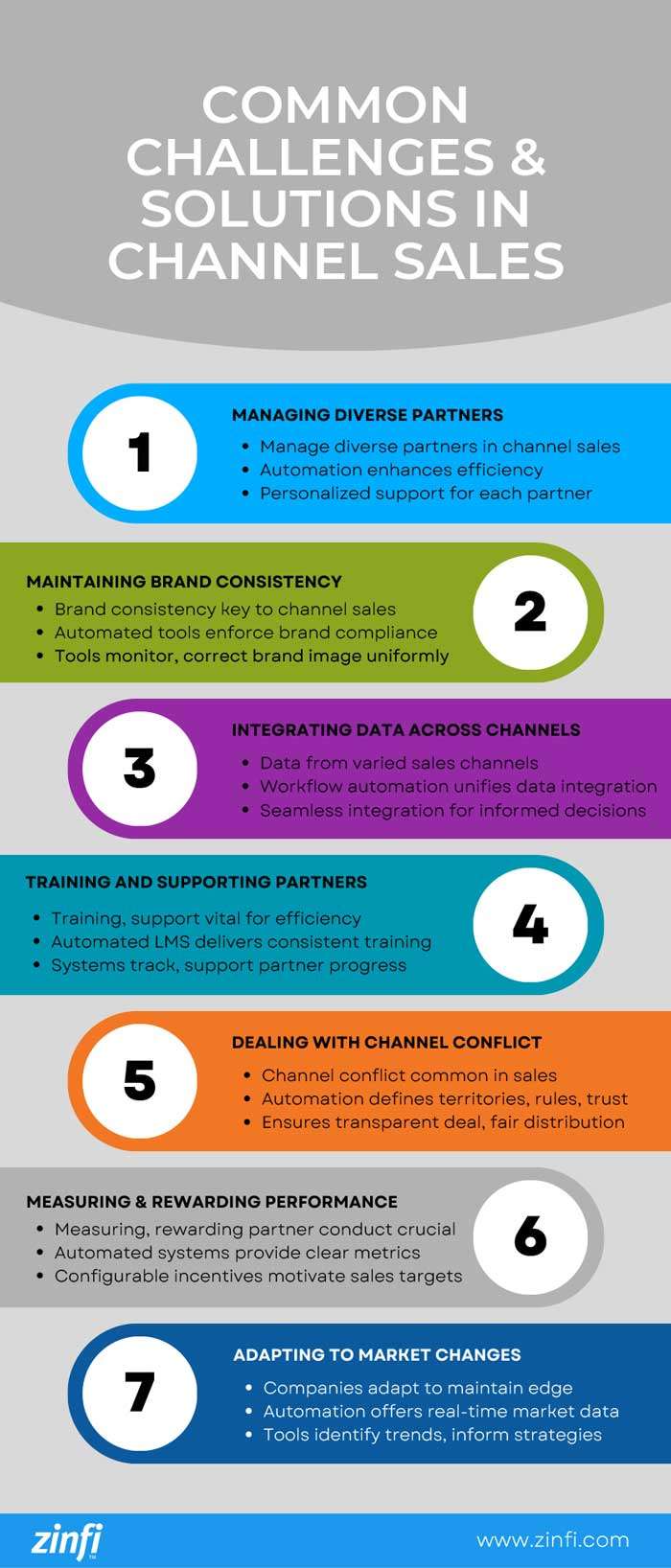
- Managing diverse partners: In channel sales, managing a spectrum of partners, each with unique strengths, market focus, and operational needs, is a complex task. Automation tools can make this process easier and more efficient by providing standardized management protocols while allowing customization. These tools track partner performance, preferences, and needs, and you can use this information to provide personalized support and engagement strategies that cater to each partner’s unique profile.
- Maintaining brand consistency: Brand consistency is a cornerstone of successful channel sales. Automated marketing tools ensure that all partners adhere to brand guidelines and messaging. These tools can distribute consistent marketing materials, monitor brand usage, and provide real-time feedback and corrections to maintain a unified brand image across diverse sales channels.
- Integrating data across channels: Data from multiple sales channels presents a significant challenge because it typically comes in various formats and from numerous sources. Workflow automation solves this problem by providing centralized data collection, integration, and analysis from a single platform or user interface. This seamless integration enables a comprehensive view of sales performance, customer feedback, and market trends, facilitating informed decision-making.
- Training and supporting partners: Effective training and support are crucial in empowering partners to sell products or services efficiently. Automated learning management systems (LMS) offer a scalable solution for delivering consistent, up-to-date training materials and assessments. These systems track partner progress, identify areas for improvement, and provide ongoing support, ensuring partners are well-equipped to meet sales objectives.
- Dealing with channel conflict: Channel conflict is a common challenge in multi-channel sales strategies; it can lead to competitive tensions and inefficiencies. Automation tools help mitigate these conflicts by clearly defining sales territories, rules, and partner responsibilities. They allow you to make sure that deal registration processes are transparent and lead distribution is equitable, preventing overlaps and fostering collaboration among different sales channels.
- Measuring and rewarding performance: Accurately measuring and rewarding partner performance are critical factors in motivating and retaining channel partners. Automated tracking systems and incentive management platforms provide objective and transparent performance metrics. These systems can be configured to administer rewards and incentives based on predefined criteria. This ensures programs are fair and motivates partners to achieve their sales targets.
- Adapting to market changes: In the ever-evolving global business landscape, companies must remain agile as they adapt to market changes to maintain their competitive edge. Automation tools foster agility by offering real-time market data and analytics. This information allows businesses to adjust their channel sales strategies swiftly. These tools identify emerging trends, changes in customer preferences, and shifts in the competitive landscape, allowing for proactive strategy adjustments and helping companies maintain relevance in the market.
7. What are some best practices for channel sales?
Best practices for channel sales focus on selecting the right partners, providing comprehensive training, implementing effective communication strategies, and leveraging workflow automation for efficient management and data analysis.
- Careful partner selection: Selecting partners is crucial for channel sales success. It’s important to choose partners whose market presence, customer base, and business philosophy align with your own. As noted earlier, automation tools streamline this process by filtering potential partners based on predefined criteria, ensuring a better fit and more effective partnerships. This strategic alignment is critical to achieving mutual goals and maintaining a harmonious business relationship.
- Comprehensive partner training: Effective training is essential for equipping partners with the necessary skills and knowledge about your products or services. Automated learning management systems (LMS) provide scalable and consistent training across various geographical locations and time zones. These systems can also track partner progress in training programs, hmetricselping you ensure that all partners receive the requisite training to market and sell your offerings effectively and that your organization maintains quality and consistency in customer interactions.
- Effective communication: Clear and consistent communication is the backbone of successful channel partnerships. Automated communication platforms enable regular and systematic updates, ensuring all partners are informed about product changes, marketing strategies, and organizational updates. These platforms can also facilitate two-way feedback, allowing partners to share their insights and concerns, fostering a collaborative and responsive relationship.
- Data-driven decision-making: In today’s competitive market, making data-based decisions is more critical than ever. Data analytics tools provide insights into market trends, customer preferences, and partner performance. This information is crucial for making informed decisions about product positioning marketing strategies and identifying areas for improvement in your channel sales program.
- Regular performance reviews: Regular assessments of partner performance are critical to a successful channel sales program. Businesses can turn to automated reporting tools to get detailed insights into individual partner’s sales performance, analyze customer feedback, and understand their overall contribution to your business. This ongoing assessment helps you identify high-performing partners, areas where support is needed, and opportunities for further growth.
- Flexible and scalable strategies: Your channel sales strategies should evolve as your business grows. Automation tools can aid in managing the complexities that come with scaling, such as handling increased transaction volumes, expanding to new markets, or onboarding more partners. These tools ensure your strategies remain flexible and adaptable to changing business environments.
- Continuous improvement: The business landscape is constantly evolving. So should your channel sales program. To keep getting better, regularly solicit partner feedback and stay abreast of market trends. Automation tools help collect and analyze this feedback and market data so you can adapt your strategies to meet changing market demands and partner needs. This will help ensure your channel sales program remains dynamic and effective.
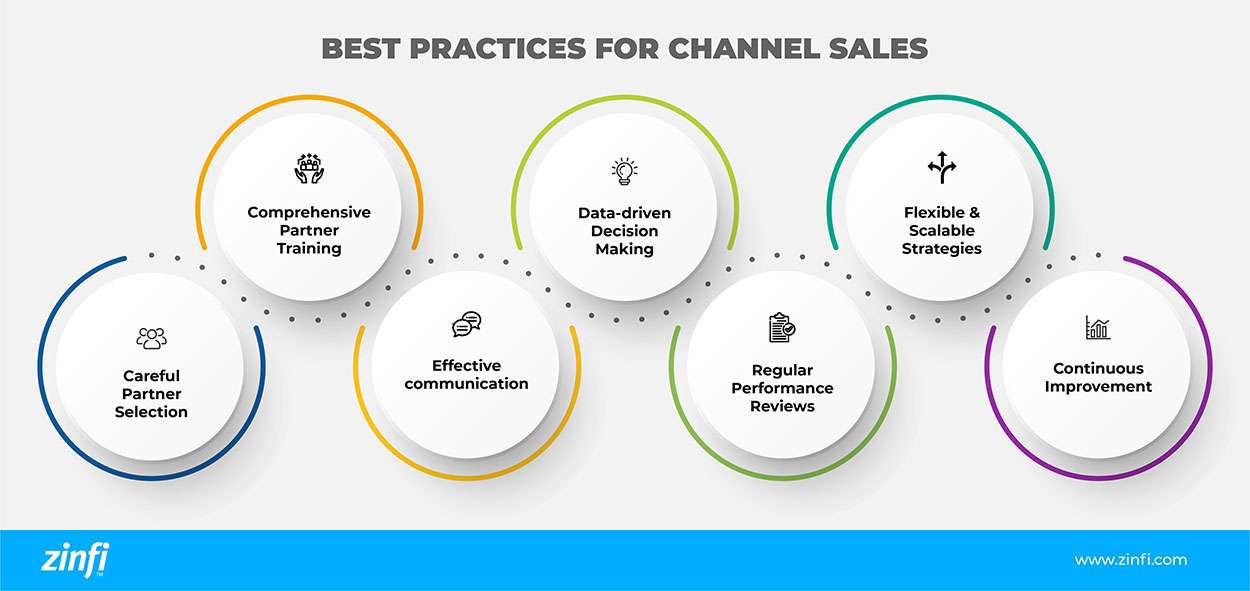
If you are looking for more best practices based on years of hands-on experience, insights derived from ZINFI’s expertise in channel sales and workflow automation provide a comprehensive guide to optimizing channel sales strategies in various aspects.
8. What are the latest trends in channel sales?
The latest trends in channel sales include the adoption of advanced technologies, a focus on partner experience, data-driven decision-making, and rising ecosystem partnerships. Workflow automation – which enhances efficiency, accuracy, and scalability – is central to these trends.
- Advanced technology integration: Integrating AI and machine learning revolutionizes channel sales by enabling more intelligent decision-making and forecasting. These technologies empower automation tools to sift through large volumes of complex data, identify patterns, and predict future trends, enhancing strategic planning and operational efficiency in channel sales.
- Enhancing partner experience: Improving the partner experience is pivotal in channel sales. Automated platforms revolutionize onboarding, training, and support processes, making them more efficient and user-friendly. This streamlines operations and fosters more robust, more productive relationships with partners, who can access resources and support more efficiently and effectively.
- Data-driven strategies: Leveraging data analytics is crucial for crafting successful channel sales strategies. By providing real-time insights and comprehensive data analysis, automation tools enable businesses to make informed decisions. This approach helps identify market opportunities, optimize sales tactics, and tailor strategies to meet the evolving needs of the market and partners.
- Ecosystem partnerships: The trend towards ecosystem partnerships reflects a collaborative approach in channel sales. By working with a network of partners who offer complementary products and services, businesses can create a more holistic solution for customers. Workflow automation is critical in managing these complex partnerships by coordinating efforts, aligning goals, and streamlining communication.
- Personalized partner engagement: Tailoring interactions and support to individual partner profiles and performance metrics is an essential trend in channel sales. Automation tools allow businesses to segment partners and customize communications and incentives accordingly precisely. This personalized approach to partner management enhances partner satisfaction and drives better performance by addressing individual partners’ specific needs and motivations.
- Focus on compliance and security: In today’s digital age, compliance and security are paramount in channel sales. Automated systems ensure that all partner interactions and data handling adhere to legal and regulatory standards. This protects the business and its partners and builds trust with customers.
- Sustainability and social responsibility: Incorporating sustainability and social responsibility principles into channel sales strategies is rapidly gaining momentum. Automation tools are instrumental in tracking and reporting on these initiatives, allowing businesses to demonstrate their commitment to ethical practices and sustainable growth with actual data. This approach aligns with global trends and resonates with increasingly environmentally and socially conscious consumers and partners.
9. How can I use technology to improve my channel sales program?
As we have made clear throughout this article, technology – particularly workflow automation – can significantly improve a channel sales program by enhancing partner management, streamlining communication, providing data analytics, and automating administrative tasks. Let’s briefly review the primary benefits of workflow automation technology in channel sales:
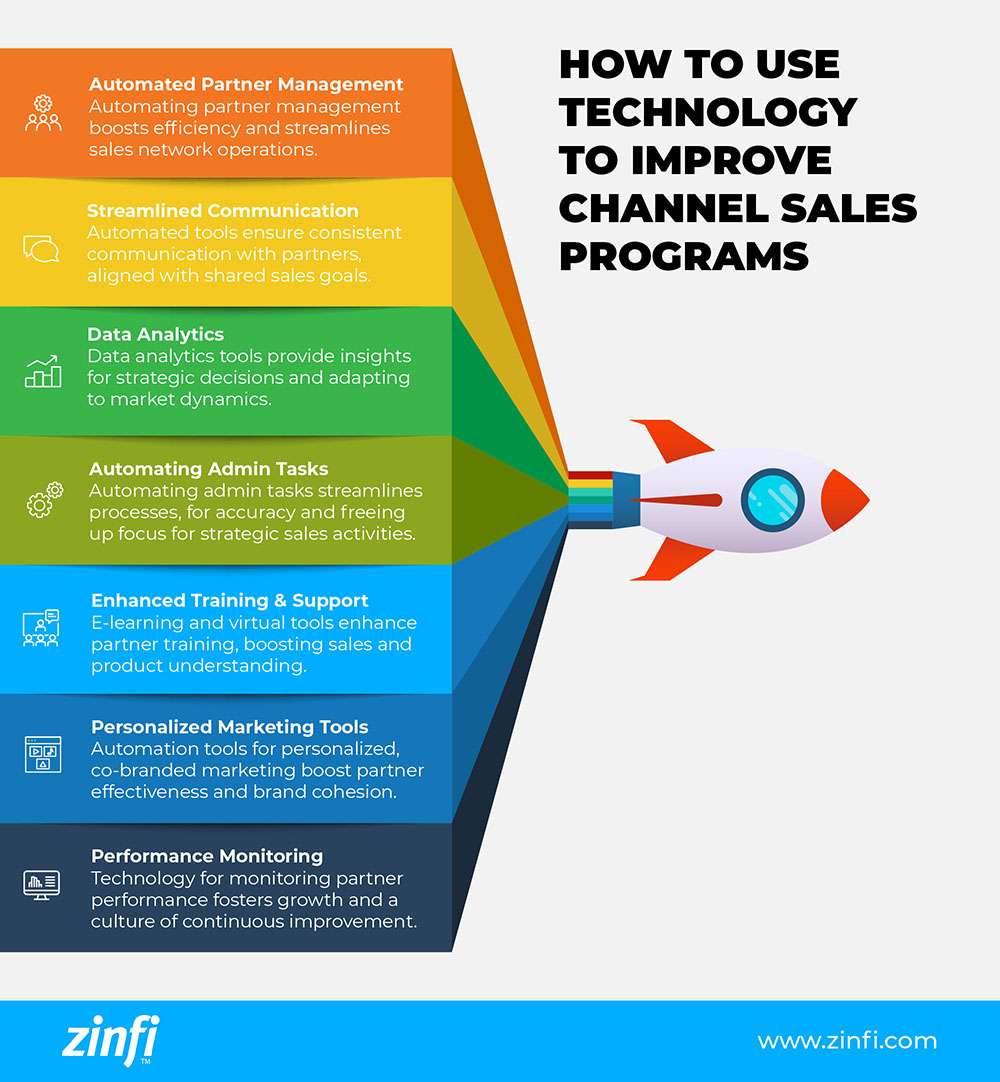
- Automated partner management: By employing technology to automate the processes of partner recruitment, onboarding, training, and performance tracking, businesses can significantly enhance efficiency. This approach streamlines operations and ensures consistency in managing partner relationships, leading to a more cohesive and productive channel sales network.
- Streamlined communication: Implementing tools that automate and streamline communication with partners is crucial for maintaining a smooth flow of information. This ensures that all partners receive timely updates, consistent messaging, and clear directives – essential practices for aligning strategies and achieving common sales goals.
- Data analytics for informed decisions: Utilizing data analytics tools is pivotal in understanding market trends, evaluating partner performance, and grasping customer preferences. These insights help businesses make strategic, data-driven decisions, enhance channel sales programs’ effectiveness, and quickly adapt to changing market dynamics.
- Automating administrative tasks: Automating administrative tasks such as contract management, incentive calculations, and compliance checks significantly reduces the workload on your team. This streamlines internal processes and ensures accuracy and compliance, allowing the team to focus on more strategic aspects of channel sales.
- Enhanced training and support: Leveraging e-learning platforms and virtual training tools offers a comprehensive and accessible approach to partner training. These tools help you ensure that partners are well-equipped with the necessary knowledge and skills, allowing them to improve their sales performance and achieve a more robust understanding of your products and services.
- Personalized marketing tools: Using automation tools that enable partners to personalize and co-brand marketing materials is a game-changer. These tools empower partners to tailor their marketing efforts to specific audiences, helping them run more effective sales campaigns while at the same time presenting a more cohesive brand image.
- Performance monitoring and feedback: Employing technology for continuous monitoring of partner performance and providing constructive feedback is essential for the growth and improvement of channel partners. This approach helps identify areas of improvement and encourages a culture of continuous learning and development within the partner network.
10. What are some resources that can help me with channel sales?
Resources aiding channel sales include educational materials, technology platforms, professional networks, and industry events. Leveraging these resources, especially with the integration of workflow automation, can enhance the effectiveness of your channel sales program.
- Educational materials: The wealth of educational materials available, ranging from in-depth books to insightful articles and comprehensive online courses, offers a treasure trove of knowledge on channel sales. Leveraging automated systems to curate and recommend these resources based on individual learning styles and specific business needs is an excellent way to enhance your understanding and application of channel sales strategies and best practices.
- Technology platforms: Platforms like ZINFI are instrumental in streamlining the complexities of channel sales. They offer automated tools for efficient partner relationship management, channel marketing automation, and sales enablement. These platforms simplify the management of extensive partner networks, automate key marketing processes, and provide valuable insights into partner performance, making them indispensable in today’s technology-driven sales landscape.
- Professional networks: Joining professional networks and online communities dedicated to channel sales is strategic for any severe channel sales professional. These networks are invaluable for exchanging ideas, strategies, and experiences with peers. They offer a platform for learning from others’ successes and mistakes, staying abreast of industry developments, and potentially forming beneficial partnerships or mentorships to propel your channel sales efforts forward.
- Industry events and webinars: Keeping abreast of the latest trends and best practices in channel sales is crucial, and industry events and webinars are excellent resources for this. They provide opportunities to learn from leading experts, network with peers, and gain insights into emerging technologies and strategies. The availability of virtual attendance options has made these events more accessible, allowing professionals to participate and benefit from these learning experiences regardless of their location.
- Consulting services: Consulting firms specializing in channel sales can offer some companies a significant competitive advantage. These firms provide tailored advice, strategy development, and solutions based on extensive experience and industry knowledge. They can help you identify the most promising areas for improvement, suggest innovative strategies, and guide the implementation of best practices tailored to your business context.
For those seeking more information, these insights derived from ZINFI’s expertise in channel sales and workflow automation provide a comprehensive guide to leveraging current trends, technology, and resources to optimize channel sales strategies.

Conclusion
Integrating workflow automation into channel sales is a significant trend and a strategic necessity in today’s fast-paced business environment. As we have seen, each aspect of channel sales, from selecting partners to evaluating success, can be significantly enhanced through the judicious use of automation technologies. These tools streamline operations and provide valuable insights, enabling businesses to make data-driven decisions.
The future of channel sales lies in the harmonious blend of human expertise and technological innovation. By embracing best practices and staying abreast of the latest trends, businesses can navigate the complexities of channel partnerships more effectively. Automation is the backbone of this approach, ensuring that processes are efficient, scalable, and adaptable to changing market dynamics.
As we move forward, it’s imperative for businesses to continually assess and refine their channel sales strategies, incorporating advanced technologies to stay competitive. The resources and insights in this article should be a starting point for any business looking to optimize its channel sales program through workflow automation.
Successfully integrating workflow automation in channel sales is a journey, not a destination. It requires ongoing commitment, adaptation, and learning. By embracing this approach, businesses can unlock new efficiencies, greater profitability, and accelerated growth in their channel sales endeavors.
For more information, please check this article.


Best Practices Guidebook
 How to Start and Scale Partner Ecosystems Best Practices
How to Start and Scale Partner Ecosystems Best PracticesDownload Guide
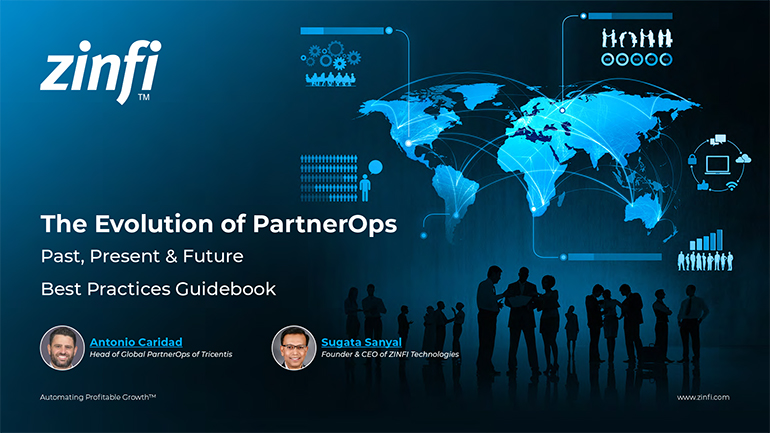 The Evolution of PartnerOps: Past, Present & Future Best Practices
The Evolution of PartnerOps: Past, Present & Future Best PracticesDownload Guide
 Mastering Channel Sales: Strategies, Best Practices, and Growth Tactics for 2025
Mastering Channel Sales: Strategies, Best Practices, and Growth Tactics for 2025Download Guide
 Winning with Partner Advisory Councils: Best Practices for Partner Engagement & Growth
Winning with Partner Advisory Councils: Best Practices for Partner Engagement & GrowthDownload Guide
 The Future of Partner Ecosystems Best Practices
The Future of Partner Ecosystems Best PracticesDownload Guide
 The AI Revolution: How Technology and Talent are Shaping the Future
The AI Revolution: How Technology and Talent are Shaping the FutureDownload Guide
 Top 105 Partner Management Metrics that Matter Best Practices
Top 105 Partner Management Metrics that Matter Best PracticesDownload Guide
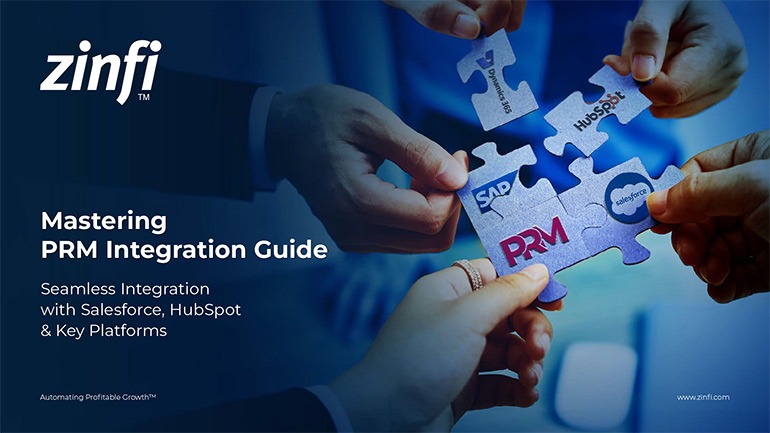 Mastering PRM Integration Best Practices
Mastering PRM Integration Best PracticesDownload Guide
 Building a Sales Partner Portal with Salesforce Best Practices
Building a Sales Partner Portal with Salesforce Best PracticesDownload Guide
 Building and Managing Partner Ecosystems Best Practices
Building and Managing Partner Ecosystems Best PracticesDownload Guide
 Mastering Co-Marketing and Co-Selling Best Practices
Mastering Co-Marketing and Co-Selling Best PracticesDownload Guide
 Transforming Partner Ecosystems Best Practices
Transforming Partner Ecosystems Best PracticesDownload Guide
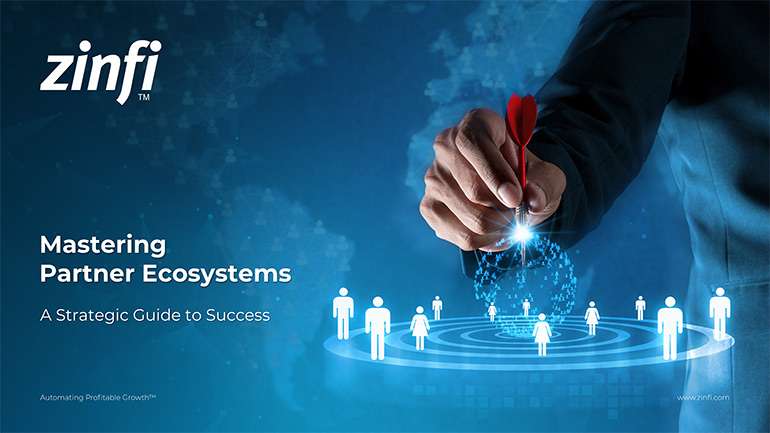 Mastering Partner Ecosystems Best Practices
Mastering Partner Ecosystems Best PracticesDownload Guide
 Mastering Partner Onboarding Best Practices
Mastering Partner Onboarding Best PracticesDownload Guide
 Partner Ecosystem Management Best Practices
Partner Ecosystem Management Best PracticesDownload Guide
 B2B Marketing in the Age of Intelligence Best Practices
B2B Marketing in the Age of Intelligence Best PracticesDownload Guide
 Multi-Partner Co-Selling Best Practices
Multi-Partner Co-Selling Best PracticesDownload Guide
 A Guide to Enhance Channel Sales Efficiency
A Guide to Enhance Channel Sales EfficiencyDownload Guide







